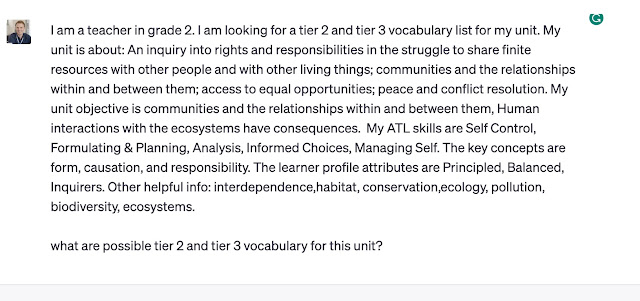After adjusting the level of the lists, the words "rights" and "responsibilities" were moved to a category of more importance.
Then I decided to ask for activities that were suitable for the lists. This gave me some pretty good ideas, but I mis-prompted and forgot Tier 3 words.
The screenshots are hard to read, so the exchange is typed out below:
Here is another
I am a teacher in grade 2. I am looking for a tier 2 and tier 3 vocabulary list for my unit. My unit is about: An inquiry into rights and responsibilities in the struggle to share finite resources with other people and with other living things; communities and the relationships within and between them; access to equal opportunities; peace and conflict resolution. My unit objective is communities and the relationships within and between them, Human interactions with the ecosystems have consequences. My ATL skills are Self Control, Formulating & Planning, Analysis, Informed Choices, Managing Self. The key concepts are form, causation, and responsibility. The learner profile attributes are Principled, Balanced, Inquirers. Other helpful info: interdependence,habitat, conservation,ecology, pollution, biodiversity, ecosystems.
make sure the words are appropriate for grade 2
===
Sure, here are some tier 1, tier 2, and tier 3 vocabulary words that you can use for your unit on communities and the relationships within and between them, Human interactions with the ecosystems have consequences.
Tier 1 Vocabulary:
- community
- environment
- resource
- finite
- struggle
- share
- responsibility
- interaction
- consequence
Tier 2 Vocabulary:
- interdependence
- habitat
- conservation
- ecology
- pollution
- biodiversity
- ecosystem
Tier 3 Vocabulary:
- causation
- informed choice
- managing self
- principled
- balanced
- inquirer
Here are some activities that you can use to help students learn and use these vocabulary words:
- Word sorts: Students can sort words into categories, such as nouns, verbs, adjectives, and adverbs.
- Word walls: Students can create a visual display of words that they are learning. They can illustrate the words or draw pictures that represent them.
- Frayer models: Students can create a Frayer model to show the meaning of a word. They can write the word in the center of the Frayer model and then write its definition, synonyms, antonyms, and examples around the word.
- Word hunts: Students can search for words in a text or in the environment. They can write down the words that they find and then look up the meaning of the words in a dictionary.
- Word games: Students can play games that involve using vocabulary words, such as Scrabble, Boggle, or Taboo.
Here are some specific activities that you can use for grade 2 students:
Tier 1:
- Word sorts: Students can sort words into categories, such as animals, plants, or objects.
- Word walls: Students can create a word wall with words that they are learning. They can illustrate the words or draw pictures that represent them.
- Frayer models: Students can create a Frayer model to show the meaning of a word. They can write the word in the center of the Frayer model and then write its definition, synonyms, antonyms, and examples around the word.
- Word hunts: Students can search for words in a text or in the environment. They can write down the words that they find and then look up the meaning of the words in a dictionary.
- Word games: Students can play games that involve using vocabulary words, such as Scrabble, Boggle, or Taboo.
Tier 2:
- Semantic feature analysis: Students can create a semantic feature analysis chart to show the characteristics of a word. They can write the word in the center of the chart and then write its meaning, part of speech, synonyms, antonyms, and examples around the word.
- Word webs: Students can create a word web to show the related concepts of a word. They can write the word in the center of the web and then write related words and concepts around the word.
- Sentence frames: Students can use sentence frames to write sentences that include vocabulary words. They can choose from a variety of sentence frames or create their own.
- Word mapping: Students can create a map to show the related concepts of a word. They can write the word in the center of the map and then write related words and concepts around the word.
- Word projects: Students can create projects that demonstrate their understanding of vocabulary words. They can create posters, dioramas, or presentations.
Tier 3:
- Word study: Students can learn about the meaning, pronunciation, and usage of vocabulary words. They can use a variety of resources, such as dictionaries, thesauruses, and online resources to learn about the words.
- Reading: Students can read texts that contain vocabulary words and discuss the meaning of the words. They can use a variety of strategies to figure out the meaning of the words, such as context clues, word parts, and prior knowledge.
- Writing: Students can write about topics that require them to use vocabulary words. They can use the words in their writing to clarify their ideas and to make their writing more interesting.
- Speaking: Students can discuss vocabulary words with their classmates. They can explain the meaning of the words, use the words in sentences, and answer questions about the words.
- Listening: Students can listen to discussions about vocabulary words. They can pay attention to the meaning of the words, how the words are used, and how the words are related to each other.
I then showed the list to the Grade 2 teacher who again made some suggestions. If I were the homeroom teacher, I might just look at what I was given and weed them down to what I could handle teaching.
###
After writing out the above post, I put it through Bard again for general feedback. Remember to use visuals when teaching EAL learners.








